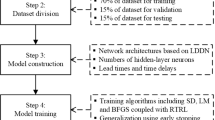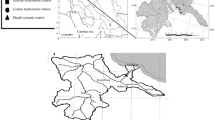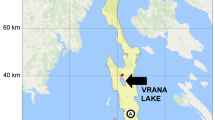Abstract
Accurate reservoir-inflow forecasting is especially important for optimizing operation of multi-propose reservoirs that provide hydropower generation, flood control, and water for domestic use and irrigation. There are no previous reports of successful daily flow prediction using a 1-year lead-time. This paper reports successful daily stream flow predictions for that extended lead-time. It presents the first NARX (Nonlinear Auto Regressive model with eXogenous inputs)-type recurrent neural network (NARX-RNN) model used to forecast daily reservoir inflow for a long lead-time. It is the first use of dynamic memory to extend the forecast lead-time beyond the previously reported 1-week lead-times. For new nonlinear NARX-RNN models, we present and test 1600 alternative structures, differing in transfer functions (2), and numbers of inputs (2 to 5), neurons per hidden layer (1 to 20), input delays and output delays. For predicting inflow to the reservoir of the multi-purpose Dez Dam, we contrast accuracies of forecasts from the new models, and from a conventional auto-regressive linear ARIMA model. Based upon normalized root-mean-square error \( \mathrm{RMSE}/{\overline{Q}}_{obs} \) the best NARX-RNN has log-sigmoid transfer functions, three inputs, one hidden layers, four neurons in the hidden layer, two input delays, and 10 output delays. That NARX-RNN structure yields \( \mathrm{RMSE}/{\overline{Q}}_{obs} \) values of 0.616 in training and 0.678 in forecasting. The proposed model’s forecasting \( \mathrm{RMSE}/{\overline{Q}}_{obs} \) is 20% lower than that of the ARIMA model.








Similar content being viewed by others
References
Akaike H (1974) A new look at the statistical model identification. IEEE Trans Autom Control AC-19(6):716–723
Baareh AKM, Sheta AF, Al khanifes K, (2006). Forecasting river flow in the USA: a comparison between auto-regression and neural network non-parametric models. J Comput Sci 2(10):775–780
Banihabib ME, Mousavi SM, Jamali FS (2008) Artificial neural network model to study the spatial and temporal correlation between stations in reservoir inflow forecasting. In: 3rd Iran Water Resources Management Conference, Tabriz, Iran (In Persian)
Chaouachi A, Kamel RM, Nagasaka K (2010) Neural network ensemble-based solar power generation short-term forecasting. JACIII 14(1):69–75
Coulibaly P, Anctil F, Bobée B (2000) Daily reservoir inflow forecasting using artificial neural networks with stopped training approach. J Hydrol 230:244–257
Cryer JD, Chan KS (2008) Time series analysis: with applications in R, second ed. Springer, New York ISBN: 0387759581; 491
Diaconescu E (2008) The use of NARX neural networks to predict chaotic time series. WSEAS Trans on Comput Res 3(3):182–191
Huang W, Xu B, Chan-Hilton A (2004) Forecasting flows in Apalachicola River using neural networks. Hydrol Process 18:2545–2564
Jeong DI, Kim YO (2005) Rainfall-runoff models using artificial neural networks for ensemble streamflow prediction. Hydrol Process 19:3819–3835
Karunasinghe DSK, Liong S (2006) Chaotic time series prediction with a global model: artificial neural network. J Hydrol 3232:92–105
Kia M (2010) Neural network on MATLAB. Kian Yarane Sabz Press, Tehran
Kisi I, Cigizoglu K (2005) Reservoir management using artificial neural networks. In: 14th. Reg. Directorate of DSI (State Hydraulic Works). Istanbul. Turkey
Lin GF, Wu M-C, Chen GR, Tsai FY (2009) An RBF-based model with an information processor for forecasting hourly reservoir inflow during typhoons. Hydrol Process 23:3598–3609
Mohammadi K, Eslami HR, Dayyani Dardashti S (2005) Comparison of regression ARIMA and ANN models for reservoir inflow forecasting using snowmelt equivalent. J Agric Sci Technol 7:17–30
Noakes DJ, McLeod AI, Hipel KW (1985) Forecasting monthly river flow time series. Int J Forecast 1:179–190
Pekarova P, Pekar J (2006) Long-term discharge prediction for the Turnu Severin station (the Danube) using a linear autoregressive model. Hydrol Process 20:1217–1228
Pulido-Calvo I, Portela MM (2007) Application of neural approaches to one-step daily flow forecasting in Portuguese watersheds. J Hydrol 332:1–15
Riad S, Mania J, Bouchaou L, Najjar Y (2004) Predicting catchment flow in a semi-arid region via an artificial neural network technique. Hydrol Process 18:2387–2393
Rojas I, Valenzuela O, Rojasa V, Guillen A, Herrera LJ, Pomares H, Marquez L, Pasadas M (2007) Hybridization of intelligent techniques and ARIMA models for time series prediction. Fuzzy Set Syst 159(7):821–845
Salas JD, Delleur JW, Yevjevich V, Lane WL (1980) Applied modeling of hydrological time series. Water Resource Publication. Littleton, Colorado
Sattaria MT, Yurekli K, Pal M (2012) Performance Evaluation of artificial neural network approaches in forecasting reservoir inflow. Appl Math Model 36:2649–2657
Shalamu A. (2009) Monthly and Seasonal Streamflow Forecasting in the RIO GRAND Basin. A thesis submitted in partial satisfaction of the requirements for the degree Doctor of Philosophy in Civil Engineering. New Mexico State University; 321
Shamseldin AY, O'Connor KM (2001) A non-linear neural network technique for updating of river flow forecasts. Hydrol Earth Syst Sci Discuss 5(4):577–598
Tawfik M (2003) Linearity versus non-linearity in forecasting Nile River flows. Adv Eng Softw 34:515–524
Valipour M, Banihabib ME, Behbahani SMR (2013) Comparison of the ARMA, ARIMA, and the autoregressive artificial neural network models in forecasting the monthly inflow of Dez dam reservoir. J Hydrol 476:433–441
Wang W, Van Gelder PH, Vrijling JK, Ma J (2006) Forecasting daily streamflow using hybrid ANN models. J Hydrol 324(1):383–399
Xie M (2001) Prediction of daily net inflows for management of reservoir systems. Master of Science Thesis in Agricultural and Biosystems Engineering. McGill University, Quebec, Canada
Xu ZX, Li JY (2002) Short-term inflow forecasting using an artificial neural network model. Hydrol Process 16:2423–2439
Yurekli K, Kurunc A, Ozturk F (2005) Application of linear stochastic models to monthly flow data of KELKIT Stream. Ecol Model 183(1):67–75
Zealand CM, Burn DH, Simonovic SP (1999) Short term streamflow forecasting using artificial neural networks. J Hydrol 214:32–48
Author information
Authors and Affiliations
Corresponding author
Ethics declarations
Conflict of Interest
None
Rights and permissions
About this article
Cite this article
Banihabib, M.E., Bandari, R. & Peralta, R.C. Auto-Regressive Neural-Network Models for Long Lead-Time Forecasting of Daily Flow. Water Resour Manage 33, 159–172 (2019). https://doi.org/10.1007/s11269-018-2094-2
Received:
Accepted:
Published:
Issue Date:
DOI: https://doi.org/10.1007/s11269-018-2094-2




